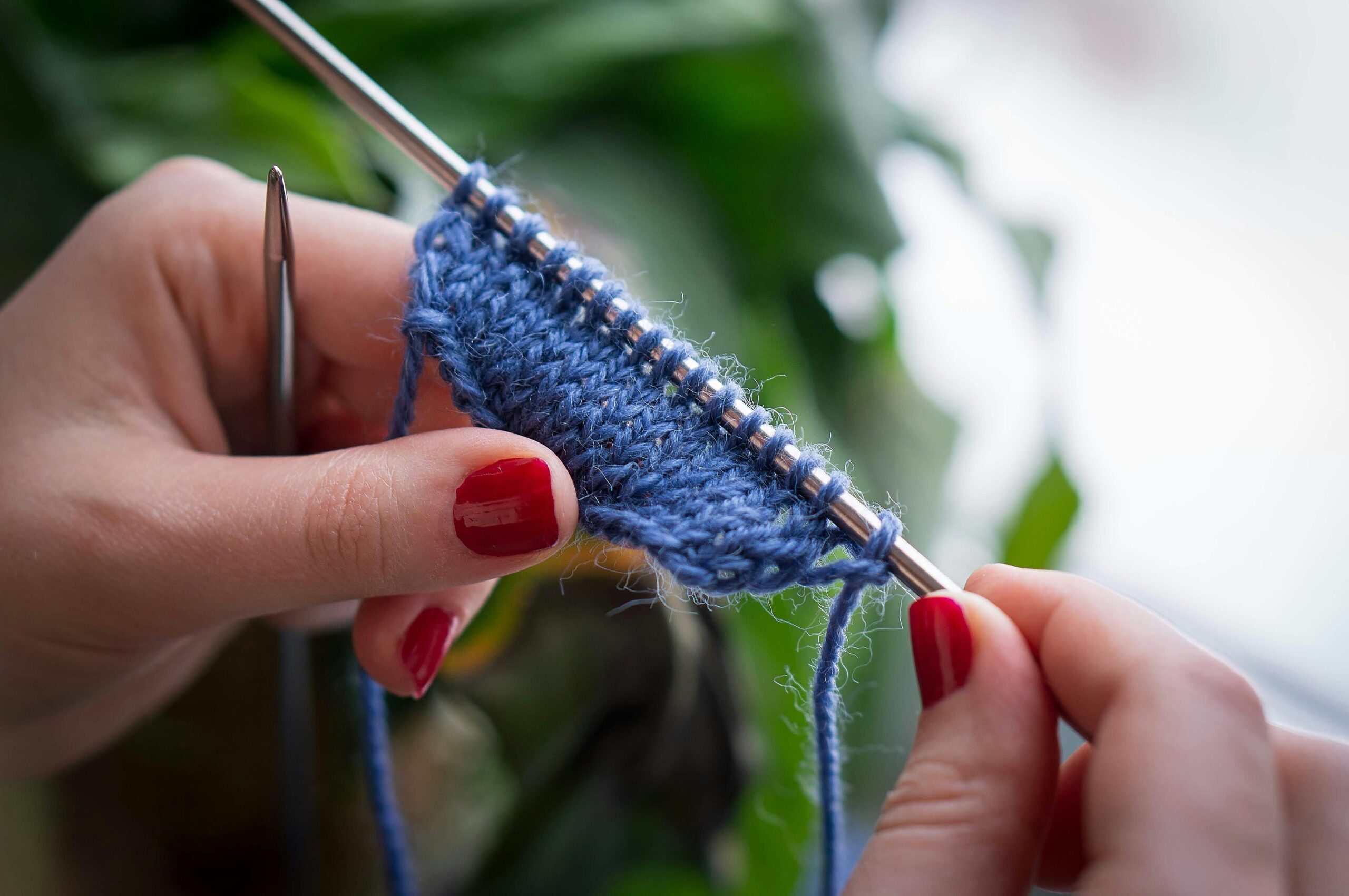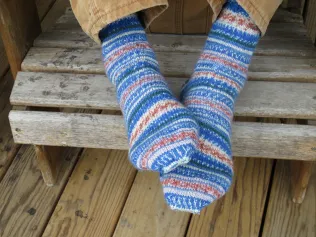For as long as I can remember, I have been a knitter. My mother and grandmother taught me to knit, sitting next to me and patiently guiding my fingers when I was about 10 years old. They gave me an appreciation for the texture of yarn, for smooth needles, and for the infinite variety of projects that can be made. I have always loved taking a skein of yarn and two needles and making a loop and crossing yarn over a needle and pulling it through, until something simple or intricate is fashioned.
Knitting is often the closest that I come to meditation. It puts me in a state of flow. I can leave my thoughts behind and simply concentrate on the rhythm of stitches upon stitches. When I knit I feel like I am in a state of zen.
Knitting has become a kind of metaphor for life for me. I have learned many life lessons from needles and yarn. Here are a few:

Slow down and pay attention. Ask my husband, I tend to do everything fast. Sometimes that serves me well as I am very efficient. Sometimes, however, it can cause more trouble than it’s worth. Knitting, especially knitting intricate patterns, forces me to slow down. I have to read patterns, count stitches, recount them and follow instructions carefully. Pay attention.
I should probably do more of this in life too. Take more time. Be more mindful. Do things more thoughtfully and deliberately. How often have I come to the end of the day and wondered, “Have I been present, truly present today?” So I practice making and drinking my coffee more slowly in the morning. When I do the laundry, I feel each piece of clothing. When I take a walk, I look and listen around me.
Take stock and check in often. No matter how slowly or deliberately you knit, you will make mistakes. You’ve misread the pattern, or dropped a stitch, or forgotten to decrease or increase at the end of the row. When that happens, you usually have two choices. Either you unravel your project and start all over, or you simply embrace the flaw and learn to see beauty in imperfection.
I tend toward perfectionism and so I often unravel a piece and start again, sometimes even several times. Every time I do, Steve groans. “I would never knit if I had to undo all my work and start over,” he often says. But I don’t mind. It’s better to catch a mistake early and rectify it than to keep going and regret it later. Other knitters are perfectly fine with the flaws–one sleeve that is a little longer than the other, the stitches that aren’t even, or the hole that appears far down in the work.
Taking stock and checking in are good skills to have in life too. Before we let a conflict or a rift get too far, might we check in with our spouse or our friend? When we fall into some bad habits, does taking stock of the consequences make us change course?
Some mistakes in life are cause for starting over. Others can never be fully mended. But either way we are reminded that the broken can be beautiful. God’s grace abounds.

Persevere. Often when you are knitting, especially a complicated pattern, you cannot see how it is all going to come together. More than once, I’ve thought that the author of a pattern made a mistake. It didn’t make sense. But when I have persevered, kept at it, and trusted the process, the piece came together in the end.
Perseverance is a good life skill. So much in life doesn’t make sense. We don’t see any pattern or design. And yet, we trust that in all things, God is working for good. That which seems meaningless can still have purpose.
Give of yourself. My kids don’t always appreciate the socks, hats, and other knitted items I give them. But I hope that they know that I have thought of them and have given them my time and energy. I have sent them my love in these stitches woven together.

Life is about offering ourselves to God and to others. That means our time, our attention, and our love. Knitting, for me, is a symbol of that. Isn’t this why the prayer shawls tknitted or crocheted by church members can make such an impact on the sick or the grieving? It is not that they need another shawl or blanket. It’s that the shawls carry prayer and presence and love. They remind us that love is incarnational, tangible.
Certainly, there are other knitters out there. What would you add? What has knitting shown you about life?
Knitting with light blue yarn photo by Marina Ermakova on Unsplash


34 Responses
Like the Rosary.
Yes!
Thanks for the memory of my own boyhood introduction to knitting by my patient—and forgiving, though perfectionist—mother, an unspoken early lesson, in those days, in transcending gender. As to perfection, I recently heard of a quip by the great pianist Vladimir Horowitz: “Why do people expect me to be perfect? Perfection is itself an imperfection!”
Everything you say is true. Our fast paced society needs those calming, restorative moments. Not only does knitting (and I might add crocheting and quilting) provide an antidote for our fast paced world, it leads to projects for family and charities that will outlive its creator and provide wonderful memories for years to come. My grandma’s doilies are still blessing me.
I find that watching TV is a colossal waste of time, but if I have knit something, I have not wasted my time.
It’s a small world Dot. You saw me on our church’s video and I find you here! I agree that Sophie has good and accurate insight on how crafts like knitting can enrich life in so many ways.
My son’s father-in-law sent me this article. He is very involved in the Reformed Church and knew of my love of knitting.
Happy knitting!
Steve
Oh, I loved this article. You captured all the intricacies and delights of knitting so well. My husband often encourages me to overlook minor mistakes, instead of re-doing hours of work. But he rarely wins this argument. Thanks so much for this beautiful and encouraging piece!
I am not a knitter but a KS (knitter’s spouse) and KSL (. . . son-in-law), and I see so many of these traits in those who have cultivated this skill. It can have practical benefits, too, beyond staying warm and looking stylish. In my first college job, when we struggled to pay our mortgage and buy groceries and provide for two newly arrived children, the extraordinary Norwegian sweaters that Susan learned to make in her spinning and knitting group helped enrich the lives of our children. One sweater was ample compensation for many, many hours of attentive child care by one of our students.
But let’s not get started on the ratio of knitting to unraveling on complicated projects.
My Dutch grandmother started knitting at the age of three, in the forest of the Veluwe, and knitted for her five younger sisters and three older brothers. Every Christmas all of us grandkids were resupplied with woolen slippers (Dutch-style, as for klompen) and mittens. She was NEVER without her knitting bag, even into her nineties. As she told us stories and taught us Dutch songs, and dissed every preacher, her hands were always moving. My favorite person in the world, ever.
You were blessed to have such an Oma!
I was. Elisabeth Nawyn, father from Bolsward, mother from Hindelopen. Her father was a gardener on an estate in the Veluwe.
I have very similar memories of my grandmother. She also started knitting when she was very young. She grew up in Wales prior to immigrating to Michigan with her family when she was 18. She saw knitting as a basic skill everyone should know how to do so she taught all of her grandchildren how to knit no matter our gender. I learned how to knit as a child but became an avid knitter in my 50s for the very reasons Sophie wrote about.
Thanks, Sophie!
I’m grateful for time to cross-stitch now – I’m left-handed and my Grams couldn’t help me get the rhythm of knitting, over, under, etc. So I stitch and make X’s with colored thread. What I learned in my handwork was that at the end of the day, I had something to show for my work. As a pastor, I often didn’t have anything to “show” for my time and energy, and with a busy household and ministry, I found and find fulfillment in completed handwork.
Beautiful Sophie! Makes me want to scrap my plans for the day and pick up my knitting needles instead. Wish I could spend the afternoon knitting with you!
Me too Amy!!
If your children don’t want those socks, I’ll take them! Beautiful!
I never could understand why knitting has come to be known as women’s craft. Sailors used to knit socks and sweaters while at sea. Our own Dutch forebearers—men and women alike—held knitting parties in the early days of Pella. During the horrible winter of 1848 when yarn supplies were running low, they knitted mittens with candle wicking. Everyone did their part.
Although I have not knit for many years, I do embroider. Choosing the colors for a pillowcase is a joyous activity.
Many years ago the fishermen not only knit socks but also Ganser sweaters as well as their nets. A lot of men would dye the yarn as well. The women would gather and spin. They would not let others who wanted to knit start until they could spin properly.
My first project was socks an I made my needles out of 2 wooden skiers for BBQing. I was so eager to start and had no needles. Thanks for this article. God is good.
Beautiful. This is why I shoot film with manual cameras.
Thanks for the memories. Five sister. I knit, I crocheted, I embroidered–I drew the line at cross-stitch! The goal appeared to be to keep me out of trouble. I learned patience. But more, I believe I learned tolerance–preparing me for parenting (63 children). We can’t unravel a life, but we can learn to overlook, forgive, forget, and biild on their strengths. (my dad spun the wool threads for our socks)
Oh Sophie! This made my day! Actually my week, or month. You articulated so very well the many aspects of knitting that delight and give life.
The unraveling never truly bothers me either. I sometimes wait until the next day, but like you said, better to catch it now rather than continuing to work on a piece that doesn’t give the deep satisfaction of a work well done. Another reason that I don’t mind unraveling is that knitting is not only about the finished project. In fact, sometimes I think that tangible thing we have at the end is really just a by-product. The product (although that is not quite the right word) is the calmness, the meditative spirit, the prayer that happens as our fingers move. Yes, knitting is a metaphor (and more) for what I value in life.
And I can see all the wool around your chair.
My lovely English Mum taught me to knit at 7years old, and I taught my daughter at the same age, she is now a sock designer on Ravelry and I knit blankets everyday for Project Linus so every child in hospital has a blankie. Knitting keeps my arthritic hands moving and useful.
Thanks, Sophie, we miss you, but we delight in your blogs. Peace and blessings.
As a therapist I have recently become very interested in the therapeutic benefits of doing Fiber Art. As a weaver I have also experienced some of the same benefits. Scientific studies are also validating these benefits and many more. Thank you for sharing your experience with knitting.
Sophie,
I was so surprised to see your article come up on my phone after all these years. Knitting has always been such a comfort to me and I think of all the years I have been knitting I only have a pair of socks that I have made. I enjoy making other happy with the gift God has given me! My mom and I used to knit for hours and now that she is gone I still feel comfort of our time together with a love for knitting.
Knitting is sociable, too. Yesterday a friend and I went for a coffee, on a whim, to discuss changing a pattern she was making. We covered family, pets, health, problems, life – and both felt the better for it. We probably wouldn’t have bothered (pleading ‘busy, busy’) if it wasn’t for the knitting.
Thank you for this beautiful article l love knitting and in knitting I find the calm and peace that s needed to understand the flow of life ,I am kind of perfectionist but sometimes I do ignore a little bit here and there
Knitting was one of the activities that helped my hands get moving again after a spinal cord injury. A dear friend came as soon as I got home to get me started again. Indeed, therapy for the body and soul!
Dear Sophie, it was so lovely to read your piece and feel close to you again after all these years. I never was a knitter myself, but I so appreciate those who are, and all fibre artists. Some call it “craft, ” but it is Art. It occurs to me that you, and other artists, do us all a great service, for in your patient work you show us how to knit community together, which is surely what we need right now. Just the response to your thoughts shows your power in creating community as you knit us together from all our different and even sundered strands of experience into one small sleeve of the communion of all the saints. Thank you, and much love to you and yours– Jenny.
Thank you Jenny! We have never gotten to Maine, but who knows? Maybe someday!
Thank you, Sophie, you inspired many of us! Even though I am not a knitter, I have made countless Swedish Weavings, and at 90 plus, I am glad I can feel some accomplishment in creating. They have helped me (create) even while recovering from surgeries. Most all have been given to folks that willingly do so much volunteer work and do not expect recognition. Others, given when going through difficult physical or emotional times in their lives.
Thank you everyone for such kind words and meaningful memories and reflections. I didn’t think this simple little blog would elicit so much, but it does show that the world is hungry for the kind of community that comes from sharing our art and craft with one another.
Dear Sophie – Truly God has “knit us” all together with the single thread that grows long enough to wrap us all up in love. I am so grateful for my knitting hands and for my wonderful doctors who performed the surgeries to relieve the pain in my thumbs – such a miracle!